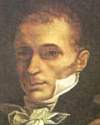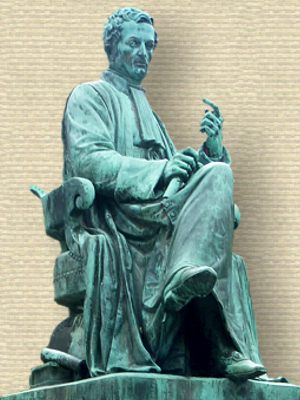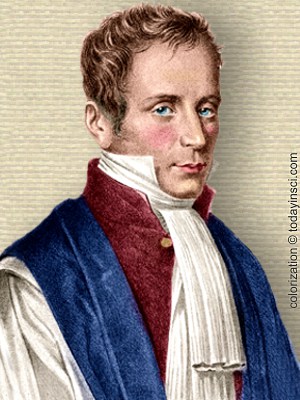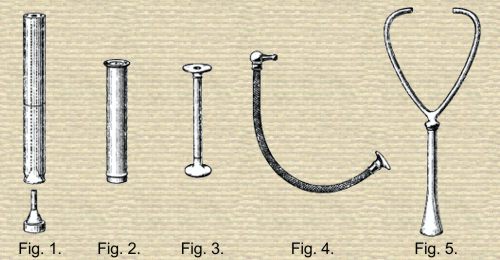 (source)
(source)
|
René Laënnec
(17 Feb 1781 - 13 Aug 1826)
French physician who invented the stethoscope and is regarded as the father of chest medicine.
|
A Lecture on
Laënnec and the Evolution of the Stethoscope
by C. Theodore Williams, M.V.O., M.A., M.D., F.R.C.P.,
Honorary Fellow of Pembroke College, Oxford; Consulting Physician to the Brompton Hospital
from The British Medical Journal (1907)
[p.6] LAËNNEC was a very remarkable man, a Breton by birth, a man of very enthusiastic disposition, distinguished by his love for his country and by his great talent for original research. At his birthplace, Quimper, the French Government erected a statue to his memory in front of the fine cathedral, and at a later date they published a cheap edition of his great work at their own expense.
His father was a lawyer, who died early, but our Laënnec was educated by an uncle, a professor of medicine at Nantes, whose influence gave a distinct bias to his studies, and he soon showed a great predilection for medicine and morbid anatomy. Shortly after he was qualified he was sent as an assistant surgeon to the Army of the West to quell the troubles in the Morbihan, and this was his only military service. On his return he went to Paris and joined the clinic of Corvisart at the Charité Hospital, at once commencing work of singular merit, chiefly in morbid anatomy.
He fortunately became acquainted with Bayle, who was also himself interested in tubercle, and the two became great friends and fellow workers. He remained three years in Paris, working indefatigably, and collected no fewer than 400 clinical cases, of which he took notes and drew up detailed descriptions, and these formed the basis of his future researches. His first published work was Histoires d’Inflammation du Péritoine, consisting of a series of cases detailed in a very clear and satisfactory manner, illustrated by much learned annotation, and terminated by general conclusions, specifying the anatomical characters and signs of peritonitis in a more accurate manner than had been previously done. His next publication was a Lettre sur la tuniques qui enveloppent certain: viscères, addressed to Dupuytren, then principal anatomist in the School of Medicine. He also gave a course of lectures on pathological anatomy, which, it seems, was his favourite study previous to his being given charge of wards.
In 1816 he was appointed chief physician to the Necker Hospital, and then it was that he took up clinical medicine, and was in the same year rewarded for his labours by the discovery of Mediate Auscultation. In June, 1818, less than two years after the introduction of the stethoscope, he published his great work entitled, De l’Auscultation Médiate, ou Traité du Diagnostic des Maladies des Poumons et du Coeur, fondé principalement sur ce nouveau moyen d’exploration. The book has gone through five editions, two of which were translated into English by Sir John Forbes and Dr. Theophilus Herbert. The production of this momentous work was too much for the delicate frame of Laënnec; it injured his health and obliged him to resort to his native air a month after its publication. He recovered after a long stay in his beloved Brittany, and returned to Paris to receive the public appreciation which his great discovery warranted. He was made Professor of Medicine and of Clinical Medicine of the College of France. His lectures were attended by zealous students from every country in Europe, among whom was the late C. J. B. Williams. He showed the utmost courtesy and consideration to all who were attracted to his clinic by his great name and the wish to perfect themselves in the use of the stethoscope, and he was a most successful teacher. Nevertheless, with all his engagements, he did not neglect his great work, which be enlarged and corrected and brought to a second edition, which again exhausted his physical powers and compelled him once more to retire to his native province.
He had been attacked with pulmonary consumption, the very disease which he had done so much to elucidate, and he died on August 13th, 1826, at the age of 45, presenting all the features of advanced consumption.
In order to estimate the debt of medicine to Laënnec we must glance at what thoracic pathology was before the stethoscope was introduced.
The only means for diagnosing lung disease or diseases of the heart were, first, the well known percussion method, invented by Avenbrugger, which Laënnec did much to advance, and, secondly, that of palpation, of which a great exponent was Dr. Matthew Baillie, who was blamed by Sir Henry Halford for thus treating a patient with too much familiarity. Thirdly, there was what has been called non-mediate auscultation, that is, simply by putting the ear to the chest wall with linen intervening. This is sometimes impossible with females, and it is not possible to auscultate the supraclavicular or suprascapular regions in this way. There was, therefore, a great want of some means of diagnosis, and Laënnec's discovery met it. His discovery was made in this way, to quote his own account: “In 1816 I was consulted by a young woman labouring under general symptoms of diseased heart, and in whose case percussion and the application of the hand were of little avail on account of the great degree of fatness. The other method just mentioned being rendered inadmissible by the age and sex of the patient, I happened to recollect a simple and well-known fact in acoustics, and fancied, at the same time, that it might be turned to some use on the present occasion. The fact I allude to is the augmented impression of sound when conveyed through certain solid bodies—as when we hear the scratch of a pin at one end of a beam of wood, on applying our ear to the other. Immediately, on this suggestion, I rolled a quire of paper into a kind of cylinder, and applied one end of it to the region of the heart and the other to my ear, and was not a little surprised and pleased to find that I could thereby perceive the action of the heart in a manner much more clear and distinct than I had ever been able to do by the immediate application of the ear. From this moment I imagined that the circumstance might furnish [p.7] means for enabling us to ascertain the character, not only of the action of the heart, but of every species of sound produced by the motion of all the thoracic viscera, and, consequently, for the exploration of the respiration, the voice, the rále or rhonchus, and perhaps even the fluctuation of fluid extravasated in the pleura. or pericardium.”
Laennec tried to make this paper into a solid body, but he could not roll it up tight enough. There was always the “longitudinal aperture” left in the paper thus rolled, and this led him accidentally to the discovery that this aperture was necessary. He had also to find a good conducting medium. He tried goldbeaters’ skin inflated with air, with the central aperture formed of pasteboard, but this did not suit. He found that the lighter kinds of wood were preferable, and consequently he translated the paper stethoscope into the wooden one. His stethoscope was made of a cylinder of boxwood 1½ in. in diameter and 13 in. long, perforated longitudinally by a bore ¾ in. wide, and hollowed out into a funnel shape to the depth of 1½ in. at one of its extremities. Here is one of his first stethoscopes, made by himself, and presented to my father. who bequeathed it to me (Fig. 1). In its construction there were two elements to be considered—first, the solid body; and second, the column of air. Laënnec thought he could hear the heart sounds better by using a stopper or plug, and the breath sounds by removing the stopper and using the conical opening as a collector of sound. He evidently had also tried different woods without the central aperture at all, for here is one of his solid stethoscopes (Fig. 2).
When Sir Charles Scudamore went to Laënnec to try this instrument (Fig. 1) it was found that he could hear nothing, on account of the large size of the tragus of his ear. Laennec accordingly hollowed out the ear-piece, and this improvement enabled Sir Charles to hear. He returned to London rejoicing, and shortly after published a pamphlet in favour of auscultation.
The next improvement came from Piorry, who reduced the stem of the instrument to the thickness of a finger, and when thus made portable it was found to convey the sounds quite as well as the solid cylinder. Next, changes were made in the pectoral end. A bell form was first employed, which certainly intensified and condensed the sound. but exaggerated it to such a degree as to lead to mistakes. The somewhat sharp rim caused pain to women and stout patients, and was complained of. C. J. B. Williams therefore suggested a trumpet-shaped ending, which gave rise to no discomfort, and. fitting close to the chest wall, confined the column of air completely and prevented any escape through tilting. By making the other end trumpet-shaped also, but of smaller size, and introducing a movable ear-piece, be facilitated auscultation above the clavicle and scapula and rendered the instrument complete, leaving to auscultators a thoroughly useful form of stethoscope (Fig. 3).
Williams next devoted considerable attention to the material for constructing the stethoscopes, using wood as a basis. He found mahogany and walnut less brittle than larch and cedar, and finally adopted ebonite on account of its strength and of the ease with which it could be cleansed. Stethoscopes should be cleaned after examination of each patient, though this is not always done, and ebonite is easily rendered aseptic. It was soon found by auscultators that it was not necessary to have a solid vibrating wall, and that one could hear as well with an indiarubber tube, where the air column was the conductor of sound, and hence the flexible monaural stethoscope (Fig. 4) came into existence. The flexible double stethoscope followed, the great advantage of which is that two ears are brought into action at the same time. If one ear only is used, the nerve of that side is more likely to become exhausted than when two are employed, and the flexibility and easy adaptability of the binaural stethoscope is of advantage. As regards accuracy. I have tried the one against the other, and the conclusion I came to was that the single stethoscope is the most accurate. The late Dr. Leared claimed to have invented the double stethoscope in 1851. I present for your inspection (Fig. 5) a curious specimen of a binaural stethoscope which my father constructed in the year 1829, and which is probably the first binaural stethoscope ever made. It consists of a trumpet-shaped chest-piece of mahogany, the end of which is screwed into a connexion to which were attached two bent lead pipes(for indiarubber had not been introduced at that time), which could be adjusted to the ears. The pipes had no earpieces or fittings of any kind, and were difficult to apply, contrasting with the later but more elegant instrument of Leared.
I show you a great variety of binaural stethoscopes, kindly lent by Mr. William Parson of Godalming, by Messrs. Hawkesley and Messrs. Krone and Seseman of London. One of the most recent is the clinical stethoscope of Dr. Aitchison Robertson, which by connecting a number of binaural tubes to one sound collector enables 10 or 12 auscultators to listen to one patient at the same time, which in cases of aneurysm of the aorta, where frequent examination is inadvisable, is very useful. It is much used at the Polyclinic lectures. Dr. Denison. of Colorado, has introduced a large condenser, which can be applied with advantage when it is desirable to elicit the character of obscure and doubtful sounds. I once was able to detect the presence of a bronchiectasis by its help which I had failed to localize by other means. The last development shown is a binaural stethoscope, designed in flexible metal and said to be of service in tropical countries, indiarubber perishes so readily. Curiously, in France, the country of Laënnec. the stethoscope has never been so extensively in use as in England and America and other countries. For a long time the French only used it for the heart, and trusted to nonmediate auscultation for the lungs. When I was a student in Paris in 1865, Professor Trousseau told us that every physician was expected by the public to auscultate, and that he knew a deaf physician who always did so. “Il ausculte toujours,” said Mons. Trousseau; “Il entend jamais.”
[p.8] Nowadays other ethods are found serviceable in the diagnosis of chest diseases, such as an examination of the sputum and the x rays, the opsonic index standard and other means. No method, however, is so simple as that of auscultation, and the stethoscope remains an instrument which all medical practitioners ought to know well, for good hearing and patience is all that is required. Some patients have no sputum to test and the shadows of the x rays may be capable of many explanations. Auscultation, therefore, holds its own and will continue to do so to the end of time.

Statue of Rene Laënnec,
in front of the Saint Corentin Cathedral, Quimper, France. It sits on a square granite pedestal as high as the statue itself. Notice his cylindrical stethoscope held in the right hand. Another stethoscope sits on a book (his treatise) on the floor beside right of seat (lower left corner of image). (source)
What Does Medical Science Owe to Laënnec?

in front of the Saint Corentin Cathedral, Quimper, France. It sits on a square granite pedestal as high as the statue itself. Notice his cylindrical stethoscope held in the right hand. Another stethoscope sits on a book (his treatise) on the floor beside right of seat (lower left corner of image). (source)
By his great discovery he bequeathed an instrument which can be used, and, though modified in its construction, has been in common use to this day. What we owe most to him is the introduction of a new sense into our investigation of disease. Our eyes and the sense of touch alone being formerly used, he taught us to use our ears. Consider that the organs of. the heart and lungs are packed into the bony cavity of the thorax and cannot be approached very easily. By bringing the sense of hearing to bear he unlocked the secrets of the heart and lungs. He further investigated thoroughly by his method the physiology and pathology of these organs. In De l’Auscultation Mediate you will find hardly any disease unnoticed. The last thing that he did was to provide a proper nomenclature for diseases of these organs. Before the invention of auscultation one could not describe the sounds of mitral stenosis, of aortic regurgitation, or of aortic obstruction. They were not known. All that was known of heart disease was that certain lesions were found after death, the diagnosis in those days being generally made on the post-mortem table. These were the grand legacies which Laënnec bequeathed to medicine, and remembering that he died at the age of 45, we must all agree that he died too soon. He attributed his death from phthisis to a post-mortem wound from a tuberculous subject, which had been neglected, and he used to cauterize this wound with butter of antimony, and he maintained that if his lungs were affected it was through this wound, which is highly interesting in the light of later experience. The nomenclature of lung and heart disease consists largely of French terms, such as “rules,” “bruit,” “bronchophonie,” and “ oegophonie,” all of which were invented by Laennec.
The late Sir Prescott Hewett used to tell a humorous story of the use of the term “bruit” in the early days of the stethoscope. When the experiments were being carried on by Dr. Hope and Dr. C. J. B. Williams on a donkey in the St. George’s Hospital dissecting room, experiments which led to the discovery of the cause of the second sound of the heart, there appears to have been on one occasion a difference of opinion. The experimenters and several medical men present could not agree as to the audibility of a bruit or murmur which one said was present, while others denied it. They bethought themselves of getting the impartial evidence of a fresh ear to decide the point, and called to their aid the dissecting room porter, who no doubt had overheard the discussion, and was beginning to get familiar with the new terminology. He applied the stethoscope to the donkey, listened attentively, and looking satisfied, said, “Yes, gentlemen, I hears the brute.”
Finally, we must never forget that, in addition to the grand field of scientific work which Laënnec opened to us, he also bequeathed his own brilliant example as an investigator.
- Science Quotes by René Laënnec.
- 17 Feb - short biography, births, deaths and events on date of Laënnec's birth.
- René Laënnec - Laënnec And Auscultation - from Pathfinders in Medicine (1912)
- Doctors: The Illustrated History of Medical Pioneers, by Sherwin B. Nuland. - book suggestion.






